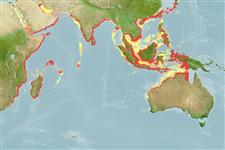Common names from other countries
Environment: milieu / climate zone / depth range / distribution range
Ecologia
Bentopelágico; estuarina; intervalo de profundidade 0 - 55 m (Ref. 409). Tropical; 31°N - 32°S, 30°E - 138°E
Indo-West Pacific: Eastern Africa to Hong Kong and Australia.
Length at first maturity / Tamanho / Peso / Idade
Maturity: Lm ? range ? - ? cm Max length : 3.2 cm BL macho/indeterminado; (Ref. 409); 4.8 cm BL (female)
Rostrum, which has two dorsal denticles or teeth, is shorter than eyes. Elongated first 3 pereiopods and no fourth and fifth pereiopods. Larger female than males. Color: in life, whole body almost transparent. Milky or yellowish when dead.
Marketed either dried, boiled, salted, fermented, fresh, or processed in other ways; consumed locally in the form of seasoning (shrimp paste/sauce) (Ref. 409).
Life cycle and mating behavior
Maturidade | Reprodução | Desova | Ovos | Fecundidade | Larvas
Members of the order Decapoda are mostly gonochoric. Mating behavior: Precopulatory courtship ritual is common (through olfactory and tactile cues); usually indirect sperm transfer.
Pérez Farfante, I. and B. Kensley. 1997. (Ref. 75620)
Categoria na Lista Vermelha da IUCN (Ref. 130435: Version 2024-1)
Categoria CITES (Ref. 108899)
Not Evaluated
Not Evaluated
Utilização humana
Pescarias: espécies comerciais
FAO - pescarias: landings | FishSource |
Ferramentas
Fontes da internet
Estimates based on models
Preferred temperature
(Ref.
115969): 24.8 - 29.1, mean 28.3 (based on 1292 cells).
Resiliência
Elevada, tempo mínimo de duplicação da população menor que 15 meses (K=1.2).
Vulnerabilidade
Low vulnerability (10 of 100).
